The Legacy of Vesuvius: Pompeii, Bay Of Naples, and Amalfi Coast
Blazing fire, blistering heat, billowing smoke… No wonder the virtuoso pizzaioli have to be skilful and quick as they manipulate the pizzas in and out of the fierce ovens at Naples’ fabled pizzerias, the mastery of their craft passed through the generations at the base of mainland Europe’s only active volcano: Vesuvius.

The respect and adulation bestowed upon the most celebrated establishments is evident when speaking to Giuseppe, a native of the Vomero neighbourhood who is fiercely loyal to his city and the region. He is convinced that living in the shadow of Vesuvius has an effect on daily life around the Bay of Naples. Like many, he credits the quality of the region’s produce — the sweetness of the tomatoes, the velvety softness of the mozzarella and even the unsurpassed crispness of the crust of the pizza dough — to an undetermined ingredient in the subterranean water supplies. Mere proximity to the volcano and its power seems to permeate the produce and instil in the people of the region a pride and a spirit unique to this part of Italy.
According to popular folklore, the Margherita pizza was devised in Naples by Raffaele Esposito, to celebrate the Queen Consort of Italy’s visit in 1889. Whatever the veracity of the tale, it is however one of the simplest, most classic of recipes, and perhaps the most successful. Comprising just three toppings — tomatoes, mozzarella and basil — the colours of the ingredients represent those of the Italian flag. If prepared according to the stringent guidelines of the Associazione Verace Pizza Napoletana (the regional dish’s own regulating body), it is a thing of beauty.
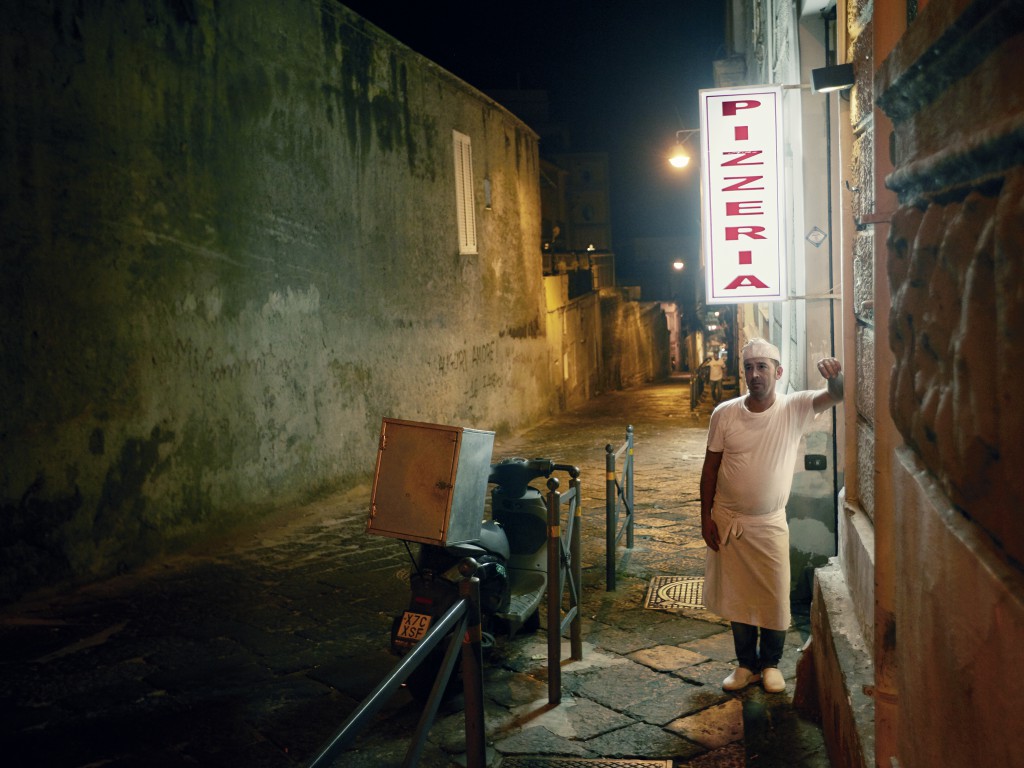
“When I go to Michele with my friends, I always order one of each!” Guiseppe exclaims, not without a hint of pride in his voice. In addition to the Margherita, L’Antica Pizzeria Da Michele on Via Cesare Sersale has served up just one other variation of traditional Neapolitan pizza since 1870, the pizza marinara. The operation is now overseen by the fifth generation of the Condurro family. The day we visit, we are welcomed by Luciano, who deftly allocates the restaurant’s 50 seats to lengthening queues of expectant visitors arriving well ahead of the busy lunchtime hour to secure a table. The interior is plain and functional, and although lingering is not encouraged, the room offers a moment of respite from the unrelenting traffic just off the busy thoroughfare of Corso Umberto I.
Of course, the intensity of the red-hot embers of the pizza oven is nothing compared with the all-consuming inferno of the volcano not far away. When Vesuvius last flared up in 1944, the temperature of the molten lava rivers reached more than twice the 485 degrees Celsius required to prepare a traditional Neapolitan pizza in 60–90 seconds. At that time, the volcano devoured the small town of San Sebastian al Vesuvio and several other villages on the western slopes of the volcano, and clouds of smoke and ash caused further damage to a large area of the Bay of Naples.

Quiet since then, Vesuvius gently towers over the area. Visible from near and far, it makes its presence felt on the landscape and the densely populated neighbourhoods at its base. The close proximity of the volcano prompts feelings of veneration and trepidation in equal measure.
A spectacular view of the cone can be had from the terrace of Grand Hotel Parker, the oldest hotel in Naples. This grande dame of Naples’ establishments is completely in keeping with the rest of the city, offering comfortable accommodation and charming service in authentically quaint surroundings. The old-school, family-run fish restaurant Da Dora is located in a narrow side street just a stone’s throw from the hotel. Above a corner table at the back of the restaurant, a painting of Vesuvius takes pride of place amongst the news clippings and pictures of famous guests on the tiled walls. Even whilst enjoying the excellent house specials of linguine alla Dora and frittura di calamari, one doesn’t lose sight of the volcano.
Setting off from Naples in the early morning and finally seeing Vesuvius closer up, the sudden lushness of the landscape on the mountainside is striking and unexpected. It is as if all the eruptions over the years have produced a volcanic soil of amazing fertility. Everything is vibrant, thriving and green, suddenly making the attractiveness of the area more understandable. To people whose livelihood depends on the farming made possible by the rich soil around the volcano, living here is a risk worth taking.
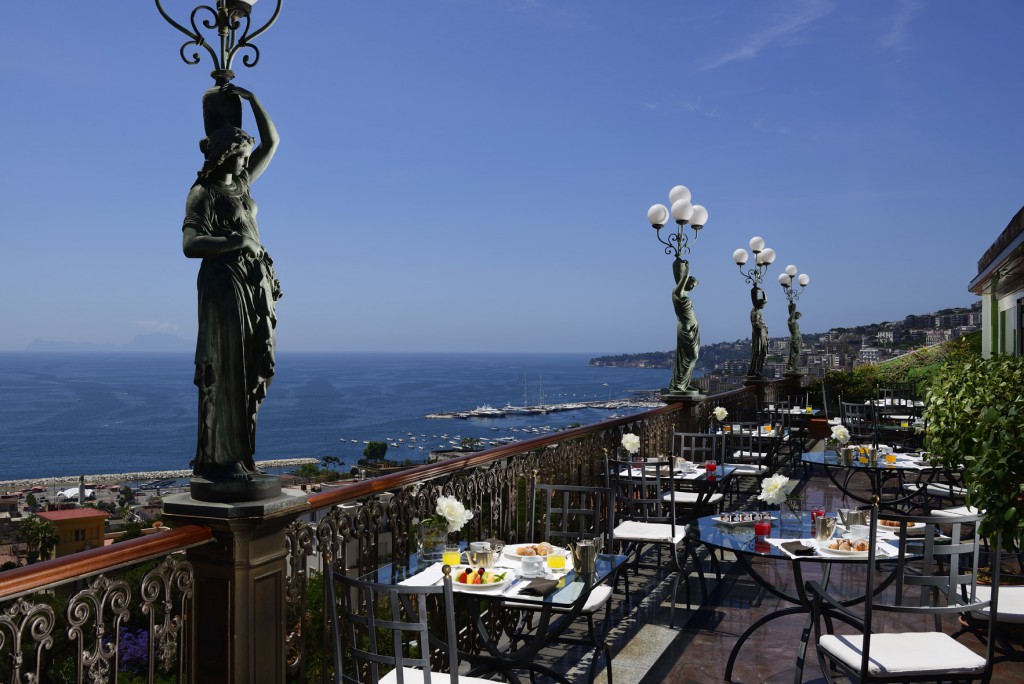
The peak of the volcano is only accessible by foot. The landscape changes again, becoming ragged, grey and lunar-like. The top is often completely shrouded by clouds, and the trail around the crater offers only periodic glimpses of the otherwise impressive views towards the Bay of Naples on one side and Pompeii on the other. The geothermal steam from the fissures in the crater mixes with the cloud formations and makes the whole experience quite otherworldly.
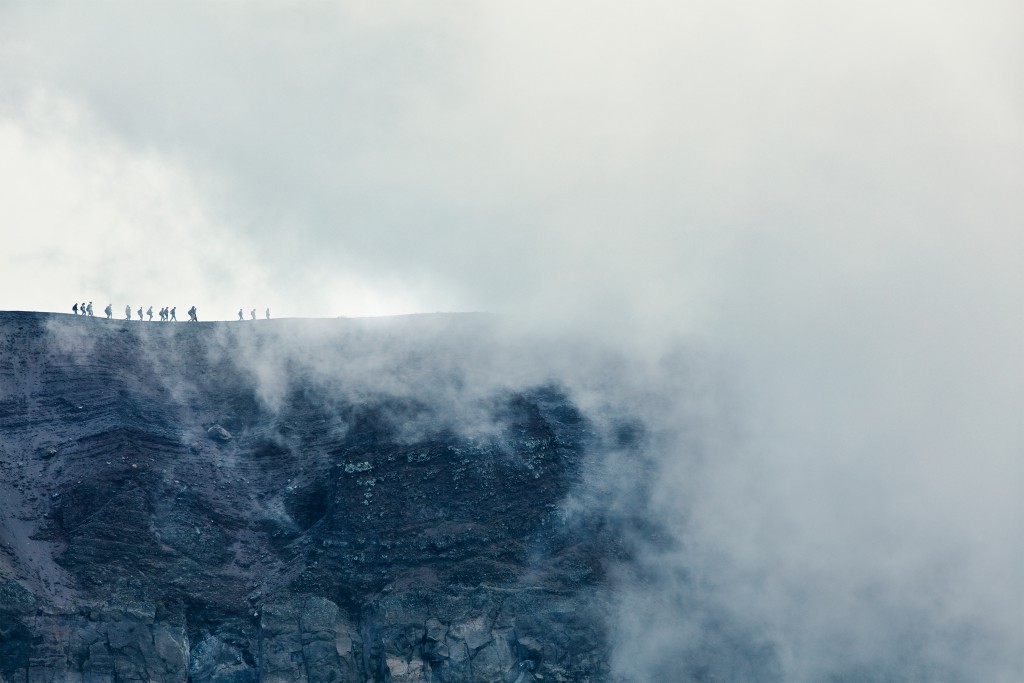
On our way down, we get momentarily lost and end up in Santa Maria delle Grazie. There is an almost delirious sense of expectancy and celebration as we pass a driveway where a family of three generations are gathered, awaiting the arrival of a pair of newlyweds. We can’t help stopping and immediately we are drawn in, surrounded by the crowd of family members, invited to take photographs and given small bite sized babà cakes, drenched in limoncello syrup. A further present of five little sugared candy almonds in a box reminds guests in the traditional Italian manner that ‘life is both bitter and sweet’. This delightful encounter perfectly encompasses the Neapolitan spirit of hospitality that we experience wherever we go.
Like the wedding guests toasting the couple, oblivious to the volcano that acts as a backdrop to the celebrations, the inhabitants of Pompeii didn’t see it coming. The destruction in 79 A.D. happened quickly, and the ash fall buried the once-bustling city, essentially freezing it in time. Walking through the well-preserved remains provides a great insight into life in the Ancient Roman Empire. Although the streets and squares do get crowded with visitors, there is still a sense of space, and the ruins don’t feel as precious and protected as some monuments from the past.
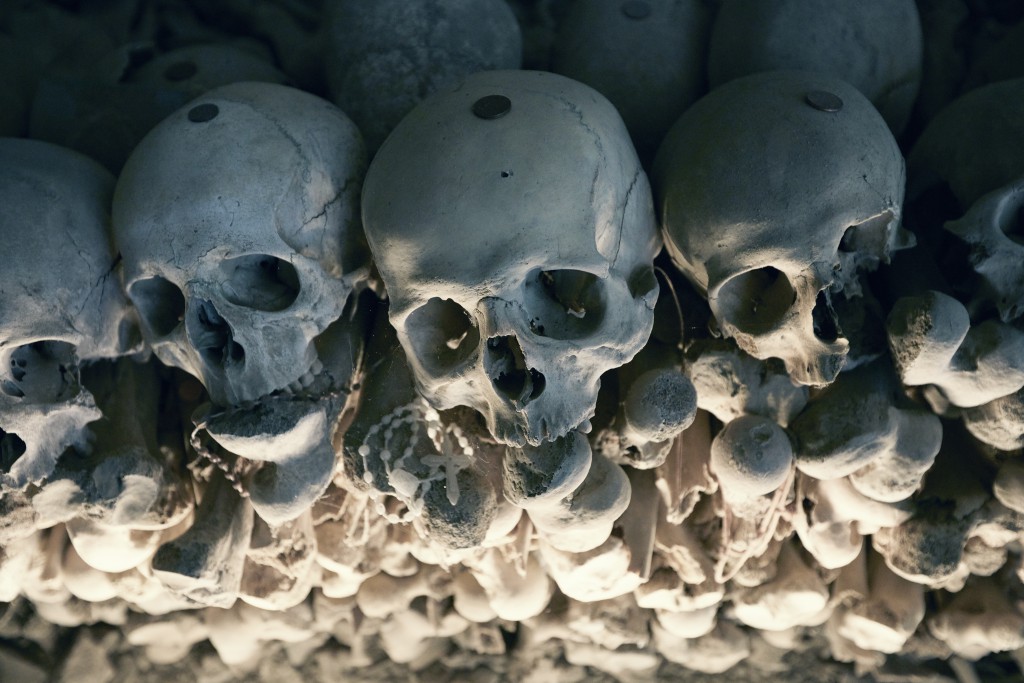
The Italians, always sensitive to design, have shown incredible restraint when it comes to the signage inside the site. This means that it is sometimes necessary to revert to a guidebook or the illuminating audio commentary available to find additional information, but there is a great sense of order within the grid layout. Visitors really get a feeling for the anatomy of the ancient city, how people lived and interacted, and their private accommodation as well as infrastructure and shared spaces. The slightly casual approach to the conservation of the site is troubling some archaeologists, but it seems to me just another example of the way things are done around here.
Seeing the volcano disappearing on the horizon as the hovercraft speeds across the bay for a short hop to Capri feels like waving goodbye to an old friend. Although it is part of the region of Campania and less than an hour away from the mainland, Capri somehow seems unique and offers a welcome escape from the furnace of Naples. On arrival, the fumes of the big city evaporate and are replaced by intoxicating, herbal scents of fennel, lemon and anise. Capri is literally a breath of fresh air. It is understandable that the island became the bolthole for Roman Emperors Augustus and Tiberius and later, via the Hollywood stars of the 50s, for the celebrities of today, escaping or embracing the paparazzi’s probing lenses according to their preference.
The island can be extremely crowded during the high season in July and August, when day trippers from Naples and Sorrento arrive to take in the highlights, and long queues form for the funicular that takes visitors from Marina Grande to the famous Piazetta in Capri Town, above. As part of its service, staff from the modern Hotel Capri Tiberio Palace meet guests at the quayside on arrival, and offer luggage transport as well as pre-purchased tickets for the funicular, potentially saving a long wait at the sole ticket office. The hotel is positioned conveniently to the town centre, but sheltered from the busiest shopping areas, providing a quick get-out for exploration of the eastern part of the island.

Although shopping is the name of the game in the narrow streets and alleys around the Piazetta, with every fashionable brand represented, the pleasure of Capri really lies in wandering along meandering paths, taking in the dramatic landscapes along the rugged coastline. The island only covers 10 square kilometres, and almost any place of interest can be accessed by foot.
The road from Capri to Anacapri, the second of the island’s main towns, is best travelled by bus or by one of many available taxis. Hiking along the short strip of zig-zagging road connecting the two towns is definitely not recommended. The local drivers know their way around here, they drive fast, and there is not much room left when two cars need to pass. Much better to climb the Phoenician Steps, all 900 of them, that lead to Anacapri from Marina Grande in under an hour. From here, a rather pleasurably swaying 12 minutes on the funicular takes us to the top of Monte Solaro, Capri’s highest point, for spectacular views back over the island towards the last stop on our tour, the fabled Amalfi Coast.
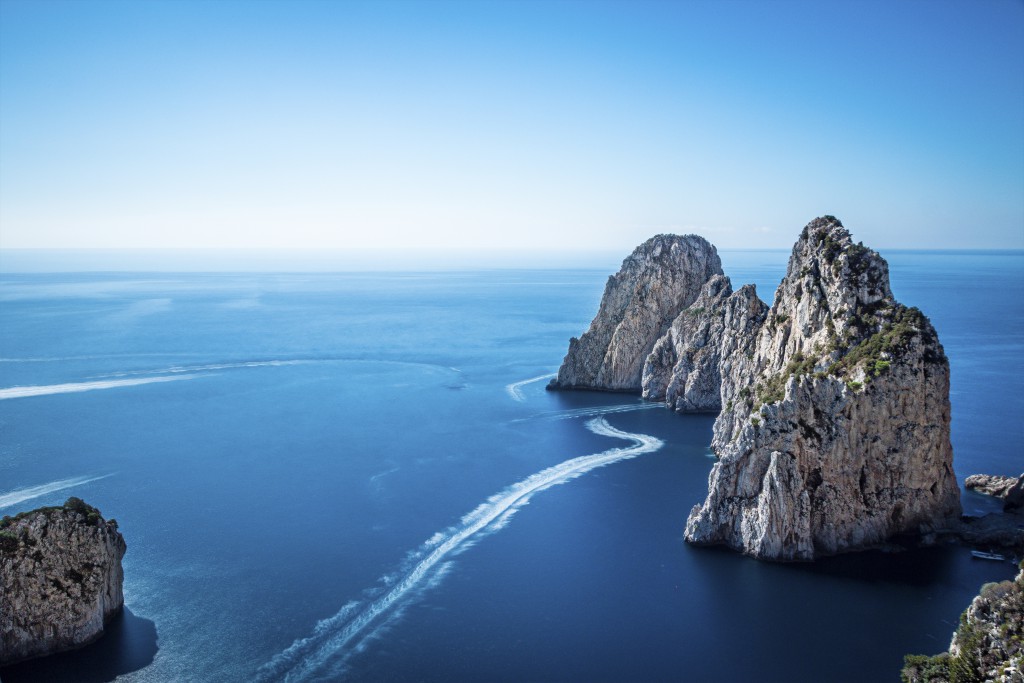
The drive along the coastal route to Hotel Casa Angelina, on the edge of the cliff near the little seaside town of Praiano, offers impressive views across the bay towards Positano. The all-white surroundings of the spa hotel provide tranquility and the extensive breakfast buffet showcases local delights of freshly cured meats and cheeses, as well as homemade cakes, bread and pastries. House-prepared small dishes of rice and pasta salads round out the extensive menu and set us up for a day of exploring the rugged coastline.
Some of the best views can be had by venturing further into the landscape, away from the hairpin turns along the seashore. Perched on the edge of the cliff, Monestero Santa Rosa sits a couple of kilometres from the seaside town of Conca dei Marini. Each room is named after herbs grown in the delightful private gardens sloping down towards the infinity pool. The subtle and discreet service is a welcome retreat from the busy tourist spots of Amalfi and Ravello just down the road. Taking a shortcut across the mountain back towards Naples and the airport, I can’t help thinking that this southern part of Italy may have fewer of the monuments, the paintings and the cultural landmarks of the north. However, this area offers an alternative understanding of Italian history and sensibility and welcomes visitors with open arms.
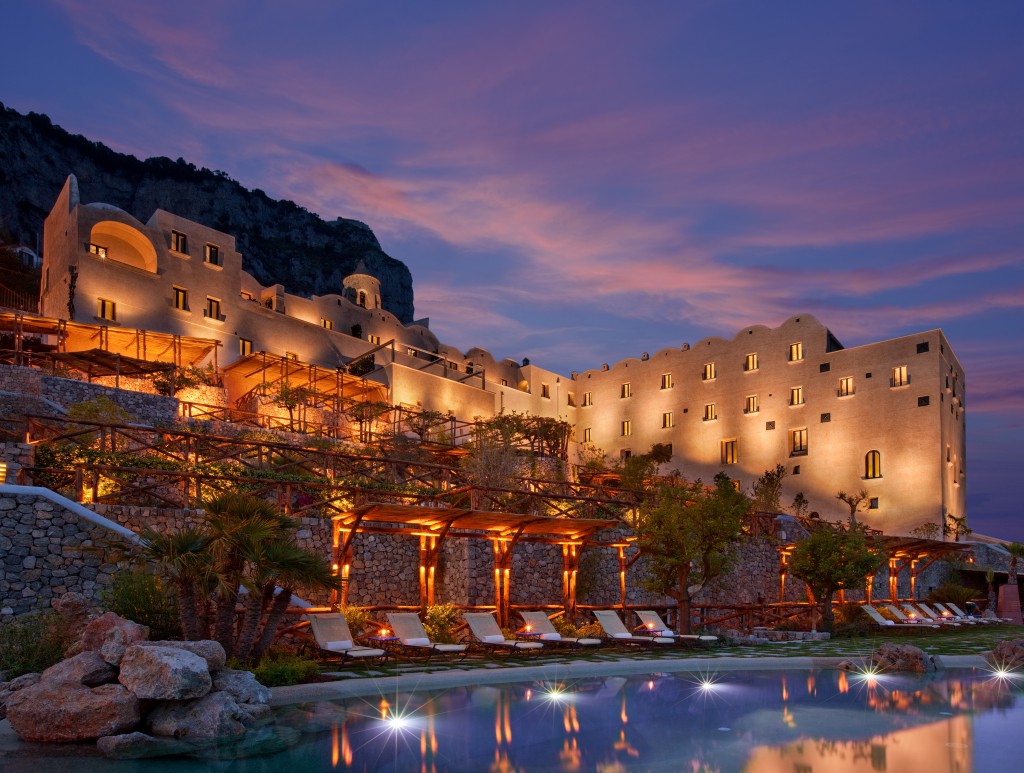
Naples is a whirlwind of action. It is a city that embraces life, beauty and decay in equal measure. The Neapolitans have long learned to live with the threat of death and destruction and this seems a natural way of daily life in the city. There is an unconcerned let’s-just-get-on-with-it attitude that permeates every bit of life here. The fact that the volcano might one day erupt again and could lay waste to entire areas of the Bay of Naples doesn’t seem to preoccupy the people we encounter. Almost everyone seems to have an optimistic and sunny outlook, taking no notice of any potential doom hanging over this corner of the world. Cities may well lie beneath the craggy deposits of ancient times. But for now, that fatal summit is dormant.
